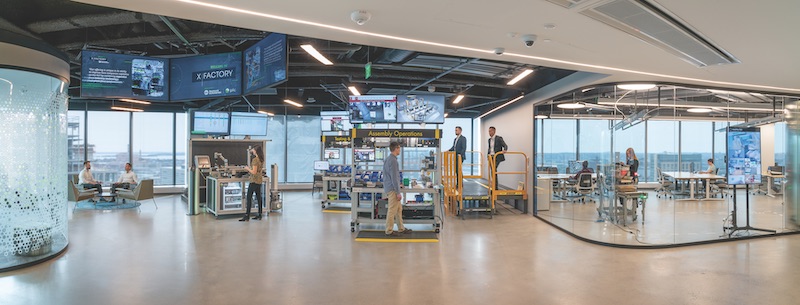For its new headquarters, PTC, a market leader in Internet of Things and augmented reality systems, took an 18½-year lease on the top nine floors of the 17-story, 400,000-sf 121 Seaport building in Boston. The company’s goal for the elaborate fitout of that 250,000-sf space was to “make its headquarters a global model for excellence in the use of workplace technology.”
End-to-end collaboration between PTC and its Building Team was instrumental in achieving that goal. It started several months before construction began when project architect Margulies Perruzzi Architects (MPA) conducted visioning and commissioning sessions with PTC and its owner’s representative, Cresa. The client also engaged the MIT Center for Real Estate to evaluate the most appropriate technology options for the project.
Because PTC’s new headquarters would be 100% unassigned seating, the Building Team constructed 5,000-sf mockups of the proposed office spaces at PTC’s old headquarters in Needham, Mass., to show employees how the new workspaces would feel and function.
PTC began its fitout even as 121 Seaport was still under construction, so the Building Team had to maintain close coordination with the core-and-shell GC, Skanska Development. This resulted in modifications of some of the fitout’s mechanical design. MPA also chose flooring materials better able to accommodate moisture from recently poured concrete slabs.
To facilitate the project’s fast-track scheduling, PTC, Cresa, MPA, and the fitout project’s GC, Gilbane Building Company, signed a “Partnership Charter” that laid out the project’s goals, identified its chain of command, and specified its achievement metrics.
To address the elliptical shape of 121 Seaport, which was designed by CBT Architects, MPA created a “radial design” of the workspaces and lounges to align with the building’s oval shape. (The Building Team referred to the office design as “the yolk.”) Early subcontractor involvement was critical for the design and installation of curved glass interior walls and, especially, lighting fixtures that became a signature component of this fitout.
The new headquarters includes more than 200 technology-enabled collaboration and huddle rooms. Each of the nine floors has a space known as The Hive, which offers employees diverse experiences for casual meetings, socialization, and quiet time. Each Hive has a different “personality,” with soft seating, high-top tables, accent lighting, vending machines, and large flat-screen TVs that provide news feeds about local community events, weather information, and PTC employee and office highlights. Employees seeking privacy can schedule time in soundproof “phone booths.”
 A welcome area with a space-age look is a greeting zone for clients, visitors, and employees. Lounges scattered throughout the building feature decorative lighting and city views.
A welcome area with a space-age look is a greeting zone for clients, visitors, and employees. Lounges scattered throughout the building feature decorative lighting and city views.
The company’s 16th-floor boardroom features a table made out of wood from a shipwreck that was discovered during 121 Seaport’s construction.
But it is on the 17th floor that this fitout really shines, starting with an elevator lobby whose dynamic LED lighting immediately grabs visitors’ attention. The lobby leads to PTC’s Corporate Experience Center (CXC), a showcase for the company’s smart technology, such as its ThinkWorx IOT and Vuforia AR platforms. The CXC has more than 20 exhibit pods that tell stories about PTC’s products and applications. Each pod has its own conference room.
The CXC includes X-Factory, a replica of a factory floor complete with a viewing platform and industrial ambience, and a Reality Lab for testing and demonstrating up and coming technologies. Each of these spaces is interactive.
Facing the CXC on the other side of the 17th floor is a large café, The Common, which serves as a multipurpose space with lots of seating that can be used for company presentations and events. The Common offers catering space, a kitchen area, state-of-the-art A/V, and a high-end sound system.
The Common is connected to the building’s landscaped roof deck by a large, curved steel and glass stair with a glass headhouse.
PTC and MPA jointly evaluated the use of disruptive workspace technologies for gathering facility data to measure space utilization and heavy-use patterns in real time. The software used included CrowdComfort, which assesses occupant comfort; Steelcase’s Room Wizard, for conference-room scheduling; and Workplace Advisor, which measures the effectiveness of workspaces.
Building Team — Submitting firm Margulies Peruzzi Architects (architect), Client PTC, Owner’s project manager Cresa, MEP/FP/IT/security design BALA Consulting Engineers, SE McNamara Salvia Structural Engineers, Building envelope engineer Simpson Gumpertz & Heger, Landscape architect CRIA/IBI Group, Lighting design Sladen Feinstein Integrated Lighting, AV systems Communications Design Associates, Acoustical design Acentech, Exhibit design consultant Amaze, Design branding/graphics 96pt., Commissioning Fitzemeyer & Tocci Associates, Code consultant AKF Group, GC (interior fitout) Gilbane Building Company
General information — Size 250,000 sf, Construction cost Withheld at owner’s request, Construction time May 2018 to January 2019, Delivery method Design-bid-build








